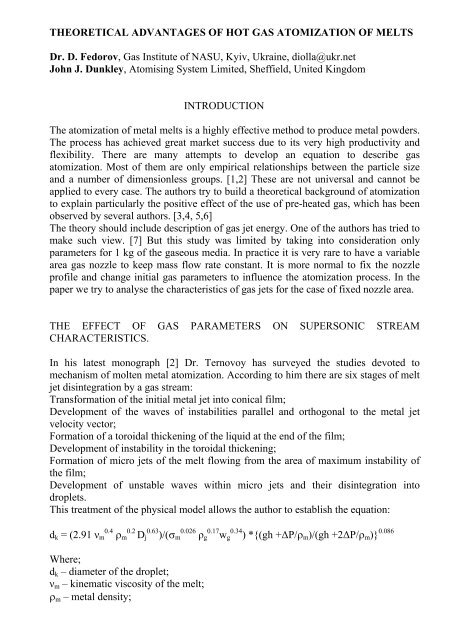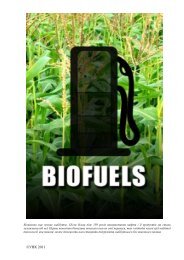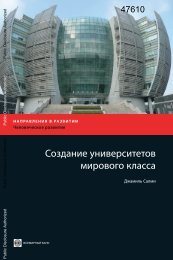THEORETICAL ADVANTAGES OF HOT GAS ATOMIZATION OF ...
THEORETICAL ADVANTAGES OF HOT GAS ATOMIZATION OF ...
THEORETICAL ADVANTAGES OF HOT GAS ATOMIZATION OF ...
You also want an ePaper? Increase the reach of your titles
YUMPU automatically turns print PDFs into web optimized ePapers that Google loves.
<strong>THEORETICAL</strong> <strong>ADVANTAGES</strong> <strong>OF</strong> <strong>HOT</strong> <strong>GAS</strong> <strong>ATOMIZATION</strong> <strong>OF</strong> MELTS<br />
Dr. D. Fedorov, Gas Institute of NASU, Kyiv, Ukraine, diolla@ukr.net<br />
John J. Dunkley, Atomising System Limited, Sheffield, United Kingdom<br />
INTRODUCTION<br />
The atomization of metal melts is a highly effective method to produce metal powders.<br />
The process has achieved great market success due to its very high productivity and<br />
flexibility. There are many attempts to develop an equation to describe gas<br />
atomization. Most of them are only empirical relationships between the particle size<br />
and a number of dimensionless groups. [1,2] These are not universal and cannot be<br />
applied to every case. The authors try to build a theoretical background of atomization<br />
to explain particularly the positive effect of the use of pre-heated gas, which has been<br />
observed by several authors. [3,4, 5,6]<br />
The theory should include description of gas jet energy. One of the authors has tried to<br />
make such view. [7] But this study was limited by taking into consideration only<br />
parameters for 1 kg of the gaseous media. In practice it is very rare to have a variable<br />
area gas nozzle to keep mass flow rate constant. It is more normal to fix the nozzle<br />
profile and change initial gas parameters to influence the atomization process. In the<br />
paper we try to analyse the characteristics of gas jets for the case of fixed nozzle area.<br />
THE EFFECT <strong>OF</strong> <strong>GAS</strong> PARAMETERS ON SUPERSONIC STREAM<br />
CHARACTERISTICS.<br />
In his latest monograph [2] Dr. Ternovoy has surveyed the studies devoted to<br />
mechanism of molten metal atomization. According to him there are six stages of melt<br />
jet disintegration by a gas stream:<br />
Transformation of the initial metal jet into conical film;<br />
Development of the waves of instabilities parallel and orthogonal to the metal jet<br />
velocity vector;<br />
Formation of a toroidal thickening of the liquid at the end of the film;<br />
Development of instability in the toroidal thickening;<br />
Formation of micro jets of the melt flowing from the area of maximum instability of<br />
the film;<br />
Development of unstable waves within micro jets and their disintegration into<br />
droplets.<br />
This treatment of the physical model allows the author to establish the equation:<br />
d k = (2.91 ν m 0.4 m<br />
0.2<br />
D j 0.63 )/( m 0.026 ρ g 0.17 w g 0.34 ) *{(gh +ΔP/ m )/(gh +2ΔP/ m )} 0.086<br />
Where;<br />
d k – diameter of the droplet;<br />
ν m – kinematic viscosity of the melt;<br />
m – metal density;
D j – diameter of metal jet;<br />
m – surface tension of the melt;<br />
ρ g – gas density;<br />
w g – gas velocity;<br />
g – gravitation acceleration;<br />
h – height between metal level and focal point of atomization;<br />
ΔP – pressure difference between metal level and metal nozzle outlet.<br />
In this equation the gas density and velocity are the most important parameters. But<br />
there is no gas to metal flow ratio at all. To include gas to metal flow ratio is more<br />
normal for empirical equations. Here instead the metal flow rate is involved through<br />
diameter of metal jet, height between metal level and focal point of atomization and<br />
pressure difference between metal level and metal nozzle outlet. We also note a very<br />
small dependence on surface tension. Gas density and velocity present the effect of its<br />
parameters. So it could be concluded that gas density and velocity are the most<br />
important. But these are not sufficient to describe the atomization process.<br />
To atomise the liquid melt the gas jet should have enough kinetic energy (power),<br />
dynamic pressure and quantity of momentum or jet force. All of these include gas flow<br />
rate.<br />
Gases are compressible and continuous. Our analysis assumes only ideal fluids. The<br />
main characteristic of gaseous media is variable density (kg/m 3 ) which depends on<br />
Temperature and Pressure. So it is better to measure gas flow rate in kg/s then in<br />
normal m 3 /s.<br />
Our terms regarding fluids are:<br />
G – mass flow rate, kg/second<br />
ρ – density, kg/m 3<br />
T – temperature, Kelvin<br />
P – pressure, MPa absolute value<br />
w – velocity, m/s<br />
R – gas constant is Universal Gas Constant 8314 J/(mol K=Degree of Kelvin) divided<br />
on mol of specific gas<br />
v – specific volume, m 3 /kg – the reciprocal of the density<br />
a 0 – velocity of sound at standard condition (P=0.1 MPa, T=273K)<br />
a loc – local velocity of sound (P=current, T=current)<br />
A – area of the nozzle, m 2<br />
M – Mach number is ratio of the actual jet velocity to the local sonic velocity<br />
λ – velocity coefficient; the ratio of actual velocity to local critical velocity (velocity at<br />
the narrowest cross-section at the current critical pressure and temperature)<br />
k – adiabatic coefficient. k = 1.66 – for monoatomic gases (He, Ag), 1.40 – for<br />
diatomic (air, N 2 ) 1.31 for CO 2 , 1.33 – for steam<br />
C v C P - heat capacity (J/(molK) at constant volume and constant pressure<br />
correspondingly (k=C p /C v )<br />
i – gas enthalpy, J/mol
sqrt(..) – means square root (All basic gas equations here and further are quoted from<br />
[8], all gas thermodynamic parameters are taken from [9])<br />
From the theory of gas dynamics it is known there is limitation of the maximum<br />
achievable gas jet velocity.<br />
This is given by:<br />
i 1 – i 2 = 0.5(w 2 2 – w 1 2 ) (1)<br />
Increasing the velocity depends on only the difference between initial and final gas<br />
enthalpy.<br />
If the initial w 1 =0 and the initial enthalpy is used entirely for acceleration (i 2 =0) we<br />
have<br />
w max =sqrt (2i 1 ) (2)<br />
i 1 =C p *T 1 (3)<br />
hence<br />
w max =sqrt (2 C p *T 1 ) (4)<br />
Thus for any initial gas temperature there is the only one maximum velocity of its jet.<br />
And it is clear that the higher the initial temperature of the gas the higher the velocity<br />
that can be achieved.<br />
To accelerate a gas jet a Laval-type nozzle is applied.<br />
A typical Laval nozzle profile is given in Fig. 1<br />
Fig. 1. Typical Laval nozzle profile<br />
As a rule a Laval nozzle outlet cross-section is calculated assuming P out = P 0<br />
As the fluid medium is continuous it is known that its mass flow rate is constant:<br />
G=Const and G= Aw (Area x Velocity x Density) kg/s (5)
Mach number is very often used to describe the behaviour of a gas stream passing<br />
through the nozzle.<br />
(M 2 -1) *w/w= A/A (6)<br />
By using the Mach number and differential equation (6) we can characterize the<br />
behaviour of the gas flowing along the nozzle.<br />
If M< 1 (subsonic case) and Area reduces then Pressure falls and Velocity rises. This<br />
is the case of the jet acceleration of the stream till sonic velocity.<br />
If M> 1 (super sonic case) and Area increases then Pressure falls and Velocity rises.<br />
This is the case for the acceleration of the stream above sonic velocity - acceleration of<br />
the stream up to P out =P 0 (Pressure of environment media)<br />
If M=1 it is the case of critical velocity of the jet. Velocity of the jet is equal to the<br />
local sonic velocity which depends on only initial gas parameters.<br />
Velocity coefficient λ is very often used to calculate the nozzle profile because it<br />
simplifies the equation.<br />
Gas flows through the nozzle adiabatically (i.e. without heat exchange with its<br />
surroundings). The gas parameters can thus be calculated using adiabatic process<br />
equations.<br />
They are here:<br />
P/ k = Const (7)<br />
P out /P in =( out / in ) k (8)<br />
T out /T in =( out / in ) (k-1) (9)<br />
T out /T in =(P out /P in ) (k-1)/k (10)<br />
Let consider the atomisation process from point of gas circulation as working media in<br />
whole. Such scheme is given in Fig. 2.<br />
Fig. 2. Schematic gas circulation in the atomisation process
Here are C – compressor, H – gas heater, E wt – energy applied to preheat the gas, E wp –<br />
energy applied to compress the gas. Initial point of the process is marked here 0.<br />
Parameters of gas are P 0 and T 0. The compressor C compresses the gas up to P 1 and T 1<br />
(Point 1) One needs to apply energy E wp here. Then gas comes to heater H where it is<br />
preheated up to T 2 at P 2 (Point 2). Applied energy is E wt. The gas expands flowing<br />
through the Laval nozzle and releases energy E k – kinetic energy of the gas jet (Point<br />
3).<br />
After interaction with metal jet, droplets and environment the gas returns to point 0.<br />
According the scheme of the Laval nozzle (Fig 1) P 1 =P 2 =P in , T 0 =T 1 , T 2 =T in , P out =P 0 ,<br />
T out T 0<br />
Thus there are following processes:-<br />
- Points 0-1 apply compressing energy:<br />
E wp = [(P 0 / 0 )*k/(k-1)]*[(P in /P 0 ) (k-1)/k -1], {J/kg} – specific energy per kg (11)<br />
-Points 1 – 2 apply preheating energy:<br />
E wt =C p (T in -T 0 ), {J/kg} – specific energy per kg (12)<br />
(Full energy in {W} is multiplied with gas flow rate G g in {kg/s}<br />
- Points 2-3 release kinetic energy:<br />
E k =0.5w out 2 G g , {W} – full kinetic energy of gas jet (13)<br />
-Points 3-0 – interaction with metal jet and recycling process of the gas.<br />
The main characteristic of any process is its effectiveness. It is necessary to apply an<br />
amount of energy to do any useful work. In our case the applied energy is E wp (energy<br />
of work to pressurize the gas) and E wt (energy to elevate its temperature). The useful<br />
energy is kinetic energy of the gas jets.<br />
Hence, effectiveness is:<br />
= E k /[G g *(E wp +E wt )] (14)<br />
Assume that the initial pressure of the gas P in =Const and only T in is variable hence<br />
E wp =Const too.<br />
Using velocity coefficient λ and following equations:<br />
w g = λ*w cr (15)<br />
w cr = sqrt(kR g T cr ) (16)<br />
T cr = T in *[1- λ cr 2 *{(k-1)/(k+1)}] (17)<br />
λ cr =1 – by definition<br />
We obtain the following equation for the effectiveness as a function of initial gas<br />
temperature and velocity coefficient:<br />
= [0.5 λ 2 kR g T in {1-(k-1)/(k+1)}]/[E wp +C p (T in -T 0 )] (18)
As for monoatomic gases k=1.66 and for diatomic gases k=1.40 we can make the<br />
equation (18) more clear:<br />
Monoatomic 1 =[0.624 λ 2 R g T in ]/[[E wp +C p (T in -T 0 )] (19)<br />
Diatomic 2 =[0.583 λ 2 R g T in ]/[[E wp +C p (T in -T 0 )] (20)<br />
The equations (19) and (20) show that with T in increasing both numerator and<br />
denominator will increase too. So with increasing of temperature of gas preheating the<br />
effectiveness of the process should change negligibly. But the opposite is true in the<br />
case of higher gas pressures. It is clear that with increasing compressing energy E wp<br />
the effectiveness must decrease.<br />
Dynamic pressure is:<br />
P gj = 0.5ρ out w out<br />
2<br />
(21)<br />
With using equations (8-10, 15-17) we can show that dynamic pressure does not<br />
depend on initial gas temperature at all. It is finally:<br />
P gj = 0.624 λ 2 P in *[(P out /P in ) 0.602 ] - for monoatomic gases (22)<br />
P gj = 0.583 λ 2 P in *[(P out /P in ) 0.714 ] - for diatomic gases (23)<br />
According to our case P in = Const and P out =P 0 =Const the dynamic pressure of the gas<br />
jets will remain constant independent of initial gas temperature. It is clear that<br />
dynamic pressure will increase with increasing velocity coefficient and growth of<br />
initial pressure of the gas.<br />
The quantity of momentum or jet force is the next gas jet characteristic.<br />
It is :<br />
F= G g w g , {kg/s* m/s = N} (24)<br />
This characteristic allows us to calculate average velocity of gas-metal spray.<br />
According to conservation of momentum there is a balance:<br />
G g w g +G m w m = w a (G g + G m ) (25)<br />
Here w a means average velocity of gas-metal spray after impaction of the gas jet with<br />
metal jet in the focal point of atomisation.<br />
Let r= G g /G m (the gas/metal ratio) and after transformation one obtains:<br />
w a =(rw g +w m )/(r+1) (26)
For the case of the fixed nozzle area, with initial increase of temperature gas flow rate<br />
and correspondingly gas to metal (mass)flow ratio will decrease but gas velocity will<br />
be rise strongly. Hence, average spray velocity will go up having a positive influence<br />
on atomisation.<br />
The examples of calculation illustrate the above conclusions:<br />
Assume the following conditions:<br />
Initial pressure<br />
P in =1 MPa (10 Bar)<br />
Initial temperature<br />
T in =293K (20C)<br />
Fixed critical area A cr =6.32 mm 2<br />
Fixed outlet area A out =10.57 mm 2<br />
Monoatomic gas<br />
Helium<br />
Diatomic gas<br />
Nitrogen<br />
Initial gas to metal flow rate ratio 1<br />
Metal jet velocity<br />
2 m/s<br />
Results of calculation for He are given in table 1.<br />
Results of calculation for N 2 are given in table 2.<br />
Fig. 3. Real kinetic energy of the gas jet vs initial temperature of the gas
Table 1 Results of calculation for Helium<br />
Data Var1 Var2 Var3 Var4 Var5 Var6 Var7 VAr8 Var9 Var10 Var11<br />
Initial Pressure, P in Bar 10 10 10 10 10 10 10 10 10 10 10<br />
Initial Temperature, T in C 20 100 200 300 400 500 600 700 800 900 1000<br />
Fixed Critical Area, mm 2 6.32 6.32 6.32 6.32 6.32 6.32 6.32 6.32 6.32 6.32 6.32<br />
Fixed Outlet Area, mm 2 10.57 10.57 10.57 10.57 10.57 10.57 10.57 10.57 10.57 10.57 10.57<br />
Standard Dens, kg/m 3 0.179 0.179 0.179 0.179 0.179 0.179 0.179 0.179 0.179 0.179 0.179<br />
Initial Density, kg/m 3 1.664 1.307 1.031 0.851 0.724 0.631 0.558 0.501 0.454 0.416 0.383<br />
R of Gas, J/kgK 2079 2079 2079 2079 2079 2079 2079 2079 2079 2079 2079<br />
Energy Compress, E wp kJ/kg 2301 2301 2301 2301 2301 2301 2301 2301 2301 2301 2301<br />
Energy Preheat, E wt kJ/kg 0 415 935 1454 1973 2493 3012 3531 4051 4570 5089<br />
Total applied Energy, kJ/kg 2301 2716 3235 3755 4274 4793 5313 5832 6351 6871 7390<br />
Out Temperature, T out C -156 -124 -84 -44 -4 36 76 117 157 197 237<br />
Out Density, kg/m 3 0.416 0.326 0.257 0.213 0.181 0.158 0.139 0.125 0.113 0.104 0.096<br />
Out Velocity, w out m/s 1355 1529 1722 1895 2054 2202 2340 2470 2594 2712 2825<br />
Mass Flow Rate, G g kg/min 0.357 0.317 0.281 0.255 0.236 0.220 0.207 0.196 0.187 0.179 0.171<br />
Kinetic Energy 1 kg, kJ/kg 919 1170 1483 1797 2111 2424 2738 3052 3365 3679 3993<br />
Dynamic Pressure, MPa 0.382 0.382 0.382 0.382 0.382 0.382 0.382 0.382 0.382 0.382 0.382<br />
Kinetic Power at real mass<br />
flow rate, kW 5.467 6.169 6.947 7.646 8.286 8.880 9.437 9.963 10.463 10.939 11.396<br />
Effectiveness,% 39.94 43.07 45.85 47.86 49.39 50.58 51.54 52.33 52.99 53.55 54.03<br />
Average velocity of the<br />
spray, m/s 679 720 760 791 818 840 859 876 892 905 917
Table 2 Results of calculation for Nitrogen<br />
Data Var1 Var2 Var3 Var4 Var5 Var6 Var7 VAr8 Var9 Var10 Var11<br />
Initial Pressure, P in Bar 10 10 10 10 10 10 10 10 10 10 10<br />
Initial Temperature, T in C 20 100 200 300 400 500 600 700 800 900 1000<br />
Fixed Critical Area, mm 2 6.32 6.32 6.32 6.32 6.32 6.32 6.32 6.32 6.32 6.32 6.32<br />
Fixed Outlet Area, mm 2 10.57 10.57 10.57 10.57 10.57 10.57 10.57 10.57 10.57 10.57 10.57<br />
Standard Dens, kg/m 3 1.250 1.250 1.250 1.250 1.250 1.250 1.250 1.250 1.250 1.250 1.250<br />
Initial Density, kg/m 3 11.647 9.149 7.214 5.955 5.070 4.415 3.909 3.507 3.180 2.909 2.681<br />
R of Gas, J/kgK 297 297 297 297 297 297 297 297 297 297 297<br />
Energy Compress, E wp<br />
kJ/kg 282 282 282 282 282 282 282 282 282 282 282<br />
Energy Preheat, E wt kJ/kg 0 83 186 291 399 508 620 734 850 968 1088<br />
Total applied Energy, kJ/kg<br />
282 364 468 573 680 790 902 1016 1132 1250 1370<br />
Out Temperature, T out C -121 -80 -28 24 76 127 179 231 283 335 386<br />
Out Density, kg/m 3 2.249 1.766 1.393 1.150 0.979 0.852 0.755 0.677 0.614 0.562 0.518<br />
Out Velocity, w out m/s 542 611 688 758 821 880 935 987 1037 1084 1129<br />
Mass Flow Rate, G g kg/min 0.773 0.685 0.608 0.553 0.510 0.476 0.448 0.424 0.404 0.386 0.371<br />
Kinetic Energy 1 kg, kJ/kg 147 187 237 287 337 387 437 487 538 588 638<br />
Dynamic Pressure, MPa 0.330 0.394 0.394 0.394 0.394 0.394 0.394 0.394 0.394 0.394 0.394<br />
Kinetic Power at real mass<br />
flow rate, kW 1.890 2.133 2.402 2.643 2.865 3.070 3.263 3.445 3.617 3.782 3.940<br />
Effectiveness,% 52.07 51.27 50.61 50.06 49.55 49.03 48.50 47.99 47.49 47.01 46.56<br />
Average velocity of the<br />
spray, m/s 272 288 304 317 328 337 344 351 357 363 368
Using data from tables 1 and 2 several plots are built.<br />
Fig. 4 Effectiveness of applied energy vs initial temperature of the gas<br />
Fig. 5 Real mass flow rate of the gas through nozzle with fixed area vs initial<br />
temperature of the gas
Fig. 6 Average velocity of the spray vs initial temperature of the gas<br />
Thus, with increasing initial gas temperature its jet velocity increases, the<br />
effectiveness of the process improves (in case of Helium) or at least remains<br />
practically the same, its dynamic pressure remains constant. In the case of fixed nozzle<br />
area gas the mass flow rate will decrease reducing gas consumption of the process and<br />
at the same time provide better average velocity of the spray.<br />
On basis of the tables 1 and 2 and plots shown in Fig.3-6 the following conclusions are<br />
drawn.<br />
CONCLUSIONS<br />
Preheating the gas greatly increases the jet velocity and its kinetic energy.<br />
Despite the decrease of gas density and its mass flow rate through a fixed nozzle, the<br />
dynamic pressure of the jet remains constant.<br />
The lighter gas (Helium) provides much higher value of kinetic energy despite the fact<br />
that its mass flow rate is half as much through the same fixed nozzle.<br />
The effectiveness of applied energy in the case of the lighter monoatomic gas grows<br />
with increasing temperature and slightly reduces in the case of nitrogen.<br />
Gas preheating, despite reducing the gas mass flow rate, increases the average spray<br />
velocity.<br />
The lighter gas provides a much higher average spray velocity due to its higher initial<br />
jet velocity.
REFERENCES<br />
1 . H Lubanska. Correlation of Spray Ring Data for Atomisation of Molten Metals. //<br />
Journal of Metals.- 1970, No22, .45-49<br />
2 . Y. F. Ternovoy, S.S. Kudievsky, N. N. Pashetneva. Engineering calculation of<br />
technological processes of molten metal atomization. – Zaporizhia. State Engineering<br />
Academy Edition. – 2005. – p. 149.<br />
3 . John J. Dunkley. Hot Gas Atomization – Economical and Engineering Aspects. –<br />
PM2004 World Congress Conference Proceedings. Volume 1 Powder Manufacturing<br />
and Processing. – Austria, Vienna. – 2004. – p. 13-19.<br />
4 . J. T. Strauss. Hotter gas increases atomization efficiency. //Metal Powder Report.<br />
– Vol.54 No11 November 1999.<br />
5 . J.T. Strauss. Closed-coupled Gas Atomization Using Elevated Temperature Gas.<br />
//Advances in Particulate Materials. – 1999. – Vol. 1. – p. 1-23 – 1-34.<br />
6 . G. Wolf, K. Till, R. Scholz. Hot Gas Atomization.// Advances in Particulate<br />
Materials. – 2002. – Vol. 3 – p. 3-163 – 3-177.<br />
7 . Dr. Fedorov. Theoretical background of hot Gas atomization. EuroPM2005<br />
European Conference Proceedings. Volume 2. – Czech Republic, Prague – 2005. – p.<br />
3-8.<br />
8 . G.N. Abramovich. Applied Gas Dynamics. Moscow. – Nauka. – 1969. – 824 p.<br />
9 . S. L. Ryvkin. Thermodynamic properties of gases. Moscow. – Energoatomizdat. –<br />
1987. – 288 p.







